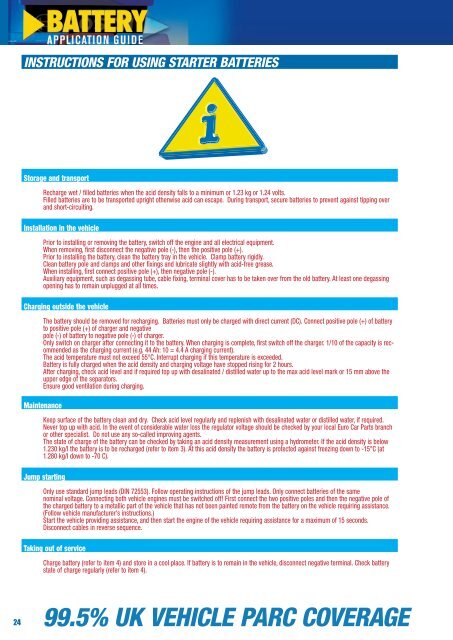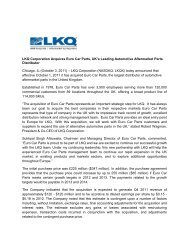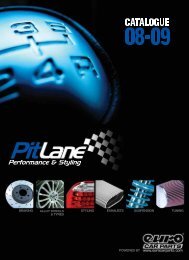Battery Catalogue - Euro Car Parts
Battery Catalogue - Euro Car Parts
Battery Catalogue - Euro Car Parts
You also want an ePaper? Increase the reach of your titles
YUMPU automatically turns print PDFs into web optimized ePapers that Google loves.
<strong>Battery</strong> <strong>Catalogue</strong> 14/7/05 09:32 Page 24<br />
24<br />
INSTRUCTIONS FOR USING STARTER BATTERIES<br />
Storage and transport<br />
Recharge wet / filled batteries when the acid density falls to a minimum or 1.23 kg or 1.24 volts.<br />
Filled batteries are to be transported upright otherwise acid can escape. During transport, secure batteries to prevent against tipping over<br />
and short-circuiting.<br />
Installation in the vehicle<br />
Prior to installing or removing the battery, switch off the engine and all electrical equipment.<br />
When removing, first disconnect the negative pole (-), then the positive pole (+).<br />
Prior to installing the battery, clean the battery tray in the vehicle. Clamp battery rigidly.<br />
Clean battery pole and clamps and other fixings and lubricate slightly with acid-free grease.<br />
When installing, first connect positive pole (+), then negative pole (-).<br />
Auxiliary equipment, such as degassing tube, cable fixing, terminal cover has to be taken over from the old battery. At least one degassing<br />
opening has to remain unplugged at all times.<br />
Charging outside the vehicle<br />
The battery should be removed for recharging. Batteries must only be charged with direct current (DC). Connect positive pole (+) of battery<br />
to positive pole (+) of charger and negative<br />
pole (-) of battery to negative pole (-) of charger.<br />
Only switch on charger after connecting it to the battery. When charging is complete, first switch off the charger. 1/10 of the capacity is recommended<br />
as the charging current (e.g. 44 Ah: 10 = 4.4 A charging current).<br />
The acid temperature must not exceed 55°C. Interrupt charging if this temperature is exceeded.<br />
<strong>Battery</strong> is fully charged when the acid density and charging voltage have stopped rising for 2 hours.<br />
After charging, check acid level and if required top up with desalinated / distilled water up to the max acid level mark or 15 mm above the<br />
upper edge of the separators.<br />
Ensure good ventilation during charging.<br />
Maintenance<br />
Keep surface of the battery clean and dry. Check acid level regularly and replenish with desalinated water or distilled water, if required.<br />
Never top up with acid. In the event of considerable water loss the regulator voltage should be checked by your local <strong>Euro</strong> <strong>Car</strong> <strong>Parts</strong> branch<br />
or other specialist. Do not use any so-called improving agents.<br />
The state of charge of the battery can be checked by taking an acid density measurement using a hydrometer. If the acid density is below<br />
1.230 kg/l the battery is to be recharged (refer to item 3). At this acid density the battery is protected against freezing down to -15°C (at<br />
1.280 kg/l down to -70 C).<br />
Jump starting<br />
Only use standard jump leads (DIN 72553). Follow operating instructions of the jump leads. Only connect batteries of the same<br />
nominal voltage. Connecting both vehicle engines must be switched off! First connect the two positive poles and then the negative pole of<br />
the charged battery to a metallic part of the vehicle that has not been painted remote from the battery on the vehicle requiring assistance.<br />
(Follow vehicle manufacturer's instructions.)<br />
Start the vehicle providing assistance, and then start the engine of the vehicle requiring assistance for a maximum of 15 seconds.<br />
Disconnect cables in reverse sequence.<br />
Taking out of service<br />
Charge battery (refer to item 4) and store in a cool place. If battery is to remain in the vehicle, disconnect negative terminal. Check battery<br />
state of charge regularly (refer to item 4).<br />
99.5% UK VEHICLE PARC COVERAGE





